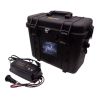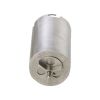Proactive Stainless Steel Mini-Monsoon XL Pump
Features
- Reliable design is suitable for continuous sampling or purging of groundwater wells
- Long lasting, high performance pump motor lasts over 400 hours under normal working conditions
- Bottom debris filter screen allows operation under harsh conditions with higher turbidity
- Free ground shipping
- Expedited repair and warranty service
- Lifetime technical support
- More
Overview
The Stainless Steel Mini-Monsoon XL pump is capable of pumping up to 80 feet from ground level by simply connecting it to a 12-volt battery.
Maintenance
The main wear-out parts, the motor and seal, have been incorporated in a single replaceable motor module. Should the existing replaceable motor module fail in the field, a new replaceable motor module can be installed within 60 seconds by a simple quarter-turn twist. Once installed, the pump is essentially new and will have a life span identical to that of a new pump.
- Power Consumption: 240 Watts (max)
- Volt Recommendation: 12-15V at source
- Maximum Amp Output: 16 Amps
- Measurements: 7.5" length x 1.82" diameter
- Construction: High polish stainless steel
- Required Tubing: 3/8" ID tubing
- (1) 12V Stainless Steel Mini-Monsoon XL pump
- (1) PVC wire lead
- (1) Motor module
- (1) Wrench
In The News
Spring 2025 Environmental Monitor Available Now
In the Spring 2025 edition of the Environmental Monitor, we highlight partnerships across the world and the importance of collaboration between government agencies, universities, environmental groups, local communities, and other stakeholders. From great white shark research in Cape Cod to monitoring fisheries in Lake Erie, this latest edition underscores partnerships that connect stakeholders in a watershed through environmental data. With an emphasis on data sharing, a combination of real-time and discrete sampling keeps the public and partners informed of environmental conditions. Our writers also sought out science professionals dedicated to working with peers within and outside of the environmental sector.
Read MoreMonitoring Mariculture in the Gulf of Alaska
The mariculture industry in the Gulf of Alaska has been steadily growing in recent years, guided by ongoing research to help refine farm location and cultivation practices. A subset of aquaculture, mariculture focuses on rearing organisms in the open ocean. In Alaska, finfish farming is illegal, so most farms cultivate kelp, oysters, or a combination of the two. These small, locally operated farms started popping up in the Gulf of Alaska in the early 1990s, when shellfish farming first became legal. Kelp farming did not begin to catch on in the state until 2016. Many of the coastal areas that have grown interested in mariculture are historically commercial fishing communities.
Read MoreSupplying Seattle’s Drinking Water: Using Data Buoys to Monitor the Cedar River Municipal Watershed
Providing clean, safe, and reliable drinking water for the 1.6 million people in the greater Seattle area is a top priority for Seattle Public Utilities (SPU). With limited water supplies, SPU dedicates considerable resources to maintain its watersheds and mountain reservoirs. About 70 percent of Seattle Water comes from the Cedar River Municipal Watershed , and the other 30 percent comes from the South Fork Tolt River Watershed . [caption id="attachment_39574" align="alignnone" width="940"] Data buoy in Chester Morse Lake . (Credit: Kevin Johnson / Seattle Public Utilities) [/caption] Jamie Thompson, a fisheries biologist at SPU, monitors aquatic ecosystems centered on fish listed under the U.S. Endangered Species Act (ESA).
Read More













